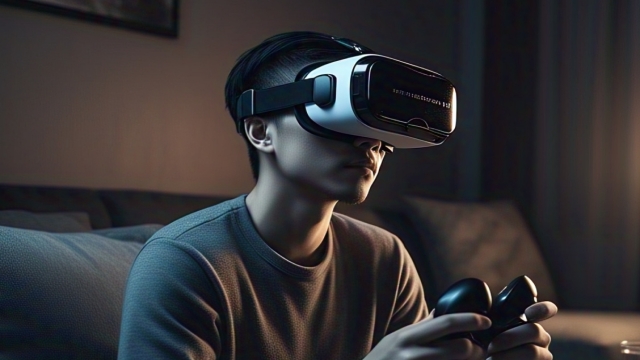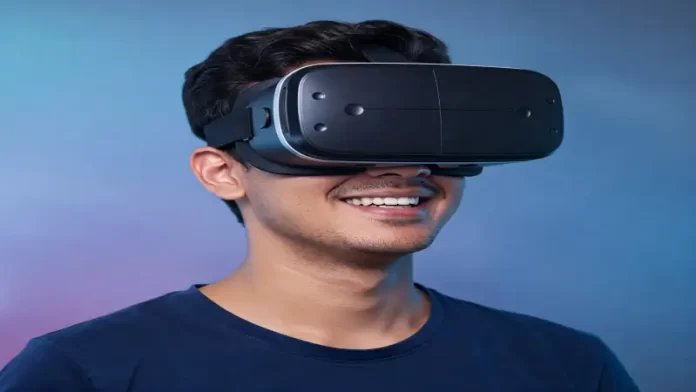Table of Contents
Facing Fears Head-On: How Virtual Reality is Changing Phobia Therapy
Ever felt that heart-pounding panic, the irrational dread that floods you when faced with… well, that thing? Maybe it’s heights. Maybe it’s spiders skittering nearby (or just the thought of them). Perhaps it’s the crushing pressure of crowded spaces or the idea of public speaking. Phobias. They’re more than just being a little scared; they can seriously hijack your life, right? For ages, the go-to treatment has been exposure therapy gradually facing the fear in a controlled way.
But lets be honest, actually holding a tarantula or standing on a real high ledge sounds… intense. What if there was a way to do it, safely, from the comfort of a therapist’s office? Enter Virtual Reality (VR) phobia therapy, a game-changer that’s making waves in mental health. Its potential to reshape how we tackle deep-seated fears is genuinely exciting.
So, What Exactly Is VR Phobia Therapy? Unpacking the Tech
At its core, VR phobia therapy is a sophisticated form of exposure therapy. Instead of facing your fear in the real world (in vivo exposure) or just imagining it (imaginal exposure), you’re immersed in a computer-generated, three-dimensional environment using a VR headset and sometimes other peripherals like gloves or controllers. Think of it like a highly realistic, interactive simulation tailored specifically to trigger, and then help you manage, your phobic response.
It sounds futuristic, almost like science fiction, don’t it? But the principle is grounded in solid psychological science. The goal isn’t just to scare you; it’s to provide a safe space where you can confront the feared object or situation in carefully managed doses. Under the guidance of a trained therapist, you learn coping mechanisms and gradually desensitize yourself to the triggers. Its a powerful tool because it tricks your brain, in a good way, into reacting as if the threat were real, allowing you to practice your response without actual physical danger.
The Science Bit: Why Does Immersive Exposure Work So Well for Fears?

Okay, let’s get into the nitty-gritty. Why is strapping on a headset potentially more effective, or at least a compelling alternative, to traditional methods for some folks? Several factors are at play:
- Graded Exposure on Steroids: Remember the core idea of exposure therapy? Start small, work your way up. VR excels here. A therapist can meticulously control the virtual environment. Afraid of flying? You don’t immediately board a turbulent flight. Maybe session one involves just looking at a virtual airport terminal. Session two, walking onto an empty plane. Session three, experiencing a smooth takeoff. Later, maybe controlled turbulence. The level of granular control is simply unmatched; the therapist can adjust variables in real-time based on your reaction, ensuring the challenge is manageable but effective. This gradual process helps your brain learn to disconnect the stimulus (e.g., height) from the panic response.
- The Safety Net is Real (Even When the Spider Isn’t): This is huge. Knowing, consciously and subconsciously, that you aren’t in actual physical danger creates a unique therapeutic window. You can explore the edges of your fear, push your boundaries, knowing you can hit pause or remove the headset anytime. This perceived safety can make people more willing to engage with stimuli they’d actively avoid in real life. Facing a virtual dog is less intimidating than facing a real barking one, especially at first.
- Control & Customization: VR environments can be tailored. Need to practice public speaking? The virtual audience size, their attentiveness, even their reactions can be programmed. Afraid of heights? The specific height, the type of ledge (balcony, cliff edge, bridge), weather conditions – it’s all adjustable. This custom fit makes the therapy highly relevant to your specific fear triggers.
- Engagement and Presence: Let’s face it, VR is pretty cool. For some, especially younger individuals or those who find traditional therapy less engaging, the novelty and immersive nature of VR can boost motivation and adherence to treatment. Feeling truly “present” in the simulated environment enhances the therapeutic effect – your brain and body react more authentically.
Step-by-Step: Your Journey Through Virtual Reality Exposure Therapy (VRET)
So you’re considering VR therapy for your phobia. What does the process actually look like? While specifics vary between clinics and therapists, a typical journey often involves these stages:
- Initial Assessment: Just like any therapy, it starts with a thorough evaluation. Your therapist will discuss your phobia, its history, its severity, how it impacts your life, and your treatment goals. They’ll also assess if VR therapy is a suitable approach for you. Sometimes, other issues needs addressing first.
- Psychoeducation: Understanding your phobia and how VR exposure works is crucial. Your therapist will explain the fight-or-flight response, the principles of habituation (getting used to the stimulus), and how VR facilitates this. Knowledge is power!
- Developing the Fear Hierarchy: Together, you and your therapist will create a list of situations related to your phobia, ranked from least scary to most terrifying. This “fear ladder” guides the VR sessions. For arachnophobia, it might start with seeing a small, cartoonish spider in the distance and eventually progress to a large, realistic tarantula crawling nearby.
- Getting Comfortable with VR: Before diving into the scary stuff, you’ll likely have a session just getting used to the headset and the virtual world. Maybe exploring a neutral, calming environment. This helps manage any potential initial disorientation or ‘cybersickness’.
- The VR Exposure Sessions: This is the core of the treatment. Guided by your therapist, you’ll enter virtual environments corresponding to steps on your fear hierarchy. The therapist monitors your anxiety levels (often using subjective ratings like SUDS – Subjective Units of Distress Scale) and guides you through coping techniques (like deep breathing or cognitive restructuring) while you’re “in” the situation. You stay at each step until your anxiety naturally decreases – this is habituation in action. The therapist help you process the experience.
- Debriefing and Skill Integration: After each session, you’ll discuss the experience with your therapist. What did you notice? How did you manage your anxiety? The goal is to integrate the coping skills learned in VR into your real-life toolkit.
- Homework and Real-World Practice: Often, VR therapy is supplemented with “homework” – applying what you’ve learned to real-world situations, starting with less challenging ones based on your progress in VR.
Phobias Commonly Tackled with VR: A Growing List

VR therapy isn’t a magic bullet for everything, but its application is surprisingly broad and growing. Some common targets include:
- Acrophobia (Fear of Heights): Virtual balconies, bridges, glass elevators.
- Arachnophobia (Fear of Spiders): Realistic spiders in various scenarios.
- Aviophobia (Fear of Flying): Simulated airport experiences, takeoffs, flights, turbulence.
- Claustrophobia (Fear of Enclosed Spaces): Virtual elevators, tunnels, small rooms.
- Glossophobia (Fear of Public Speaking): Virtual audiences of varying sizes and attentiveness.
- Social Anxiety Disorder: Simulated social interactions, parties, meetings.
- Agoraphobia (Fear of open/crowded spaces): Virtual malls, streets, public transport.
- Specific Animal Phobias: Dogs, snakes, insects.
- PTSD (Post-Traumatic Stress Disorder): Carefully recreating trauma-related environments (e.g., combat zones for veterans) in a controlled therapeutic setting. Even scenarios like public speaking is addressable effectively.
The Upside: Why Consider VR for Your Phobia Treatment?
We’ve touched on some benefits, but let’s summarise the key advantages:
- Enhanced Safety: No real-world risks. Period.
- Maximum Control: Therapists can fine-tune environments instantly.
- Increased Accessibility (Potentially): While setup costs exist, VR can simulate situations that are expensive or impractical to access repeatedly in real life (like airplanes). It can also be useful for those with mobility issues.
- Higher Engagement: The immersive nature can increase patient motivation.
- Confidentiality: Therapy happens within the privacy of the office.
- Efficiency: Some studies suggest VR might speed up the desensitization process compared to imaginal exposure because its so vivid. It makes the process much more safer and repeatable.
Hold On, Are There Downsides? The Caveats of VR Therapy
It’s not all smooth sailing, naturally. Like any tool, VR therapy has limitations:
- Cost and Accessibility: The initial investment in quality VR equipment and software can be substantial for clinics, which might affect the cost passed onto the patient. Not all therapists have access to or training in VR systems.
- Cybersickness: Some individuals experience nausea, dizziness, or eye strain, similar to motion sickness. This usually manageable but can be a barrier for some.
- Need for Trained Therapists: VR is a tool, not the therapy itself. Its effectiveness hinges on being wielded by a qualified therapist trained specifically in VRET.
- Realism vs. Reality: While VR is increasingly realistic, it’s still not real. Some argue the transfer of learned coping skills from the virtual world to the real world might not be 1:1 for everyone. Not everyone respond the same way to simulation.
- Not a Standalone Cure-All: VR is often best used as part of a broader therapeutic approach, potentially including cognitive behavioral therapy (CBT) techniques and real-world practice.
Looking Ahead: The Future of Fear-Fighting Tech is Virtual
The field of VR therapy is evolving rapidly. We’re seeing:
- Hyper-realistic Graphics: Making simulations even more convincing.
- Haptic Feedback: Gloves or suits that simulate touch or vibration, adding another layer of immersion.
- Biofeedback Integration: Systems that monitor heart rate, skin conductance, etc., giving therapists real-time data on a patient’s physiological response. Integration with biofeedback offer exciting possibilities for tailoring sessions.
- AI-Driven Environments: AI could potentially adjust scenarios dynamically based on user responses, creating even more personalized therapy.
- Wider Availability: As costs come down and awareness grows, VR therapy should become more accessible.
Wrapping Up: A New Dimension in Mental Wellness
Virtual Reality phobia therapy represents a significant leap forward in how we approach and treat debilitating fears. By offering a safe, controlled, and highly customizable environment for exposure, it empowers individuals to confront what scares them most, step by virtual step. It isn’t magic, and it requires commitment and guidance from a skilled professional, but its potential to alleviate suffering and improve quality of life is undeniable. Its an evolving field, certainly, but one filled with immense promise for anyone feeling trapped by phobia. Could this immersive technology hold the key to unlocking your cage? It’s definitely worth exploring.

